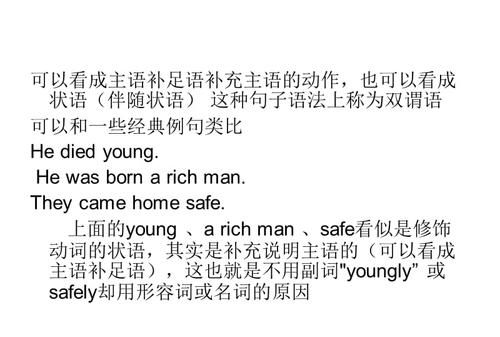本文目录
单个形容词作方式状语
修饰人做某事时状态的词,例如:upset,happy,sad,excited等等,通常用逗号把前面的句子隔开,后面只有个形容词,形容词这时表示的是谓语动词的状态(也就是主语在进行动作时,做动作的状态,一般是表示心情的词)例如:He sat on the chair,upset. (他坐在椅子上,很沮丧。)这时可以看成是形容词修饰了谓语,表示他坐在椅子上时,感觉非常沮丧。所以多用表示心情的形容词来作状语。

形容词短语作状语是什么意思
一、形容词或形容词短语作状语,表示方式或伴随,
Crusoe
stared
at
the
footprint,
full
of
fear.(=
Crusoe,
who
was
full
of
fear,
stared
at
the
footprint.)克鲁索两眼盯着脚印看,满心恐惧。
Flushed
and
breathless,
she
bounded
in
through
the
gate.
她满脸通红气喘吁吁从大门口跑了进来。
二、形容词或形容词短语可以作状语,表示时间和条件。通常位于句首,也可位于句末。
Ripe,
these
apples
are
sweet.(=When/If
these
apples
are
ripe,
they
are
sweet.)
熟了的时候这种苹果很甜。
Enthusiastic,
they
are
quite
cooperative.(=When/If
they
are
enthusiastic,
they
are
cooperative.
)
热心的时候他们是很合作的。
六、形容词或形容词短语可以作状语,
表示说话人的态度和看法。它通常位于句首。
Worse
still,
the
lion
could
even
carry
off
the
baby
in
its
mouth.更糟糕的是,狮子甚至可能把婴儿叼走。
1、形容词作状语用时,一般用逗号将其与句子的其余部分隔开.
2、形容词是用来表示程度的,有比较级和最高级。如more
important,
you
should
broaen
your
knowlege.
更重要是,你应该扩大你的知识面。more
important就是状语,important
就是形容词,指现重要性。
3、记单词时,也要记它的词性。
4、副词:修饰动词、形容词、其他副词或整个句子。按意义,可分为时间副词(如:today,
yesterday),地点副词(here,
there,
above),方式副词(如:badly,
slowly,
bravely,
),程度副词(如:enough,
very,
a
little,
a
bit,
greatly)
,频度副词(如:often,
seldom,
always,)。按句法功能可分为:句子成份(用来修饰整个句子),如:frankly,
naturally,
possibly,
surely等,疑问副词,如:when,
where,
why
how
等,关系副词,如:when
,
where,
why
等;连接副词,如when,
where,
why
so,
thus,
therefore
等。
5、另外,副词,很多是以ly结尾的。Surprising,
there
are
five
SARS
patients
in
his
family.
真惊人,他一家就有五位“非典”病人。
Necessary,
young
people
can
speak
good
English.
年轻人会说通顺的英语是必要的。

形容词做状语
形容词作状语主要表示原因、结果或伴随等。这类结构通常用从句或并列从句来改写如:He came over, eager to help。He came over and (he) was eager to help。他走过来,急于想帮忙。

说明性状语:形容词的主要是用作定语和表语,但有时也可用作状语(有人也称之为主语补足语,因为它们是补充说明主语的)。
如:He lay in bed, awake。 他躺在床上,没有睡着。(表伴随)。
He arrived home, hungry and tired。 他回到家里,又饿又累。(表结果)。
程度状语:有少数形容词,如red、 boiling、freezing、icy、bitter等,它们在某些搭配中可以起副词,用作状语,表示程度,意为“很”“非常”等。
如:The stove was red hot。火炉是炽热的。
Its boiling hot。它是滚烫的。
承上启下性状语:有些形容词在某些固定结构中可用作独立成分,起承上启下的作用。
如:Sure enough,she was there。果然她在那里。
Strange to say, he did pass his exam after all。说也奇怪,考试他竟然通过了。
形容词做状语的用法语文
形容词用作状语主要表示原因、结果或伴随等,其逻辑主语必须与句子主语保持一致。这类结构通常可用从句或并列句来改写:He came over, eager to help. / He came over and (he) was eager to help.他走过来,急于想帮忙。
形容词用作状语的三种类型
类型一:说明性状语
形容词的主要功能是用作定语和表语,但有时也可用作状语(有人也称之为主语补足语,因为它们是补充说明主语的)。如:
He lay in bed, awake. 他躺在床上,没有睡着。(表伴随)
He arrived home, hungry and tired. 他回到家里,又饿又累。(表结果)
Unable to afford the time, I had to give up the plan. 由于抽不出时间,我不得不放弃这个计划。(表原因)
形容词用作状语的特点是,该形容词的逻辑主语就是句子主语,并且通常可以用并列句或主从复合句来改写。如以上各句可改写为:
He lay in bed and he was awake.
He arrived home and he was hungry and tired.
Because I was unable to afford the time, I had to give up the plan.
类型二:程度状语
有少数形容词,如red, boiling, freezing, icy, bitter等,它们在某些搭配中可以起副词,用作状语,表示程度,意为“很”“非常”等。如:
The stove was red hot. 火炉是炽热的。
It’s boiling hot. 它是滚烫的。
His face was bright red. 他的脸是鲜红的。
The weather is freezing [icy, bitter] cold. 天气冷极了。
但这样的用法非常有限,并往往只用于某些特定搭配中,如可说 bitter cold(冰冷),bitter wind(寒风)等,但习惯上却不说 bitter hot(炽热),bitter busy(极忙)等。
类型三:承上启下性状语
有些形容词在某些固定结构中可用作独立成分,起承上启下的作用(也可视为一种状语)。如:
Sure enough, she was there. 果然她在那里。
Strange to say, he did pass his exam after all. 说也奇怪,考试他竟然通过了。
He may be late. Worse still, he may not come at all. 他可能会迟到。更糟的是,他可能根本不来。
More important, he’s got a steady job. 更重要的是他得到了一个稳定的工作。
Most remarkable of all, he never suffers from nerves on the stage. 最了不起的是他从不怯场。

以上就是关于形容词单独作状语 ,单个形容词作方式状语的全部内容,以及形容词单独作状语 的相关内容,希望能够帮到您。
